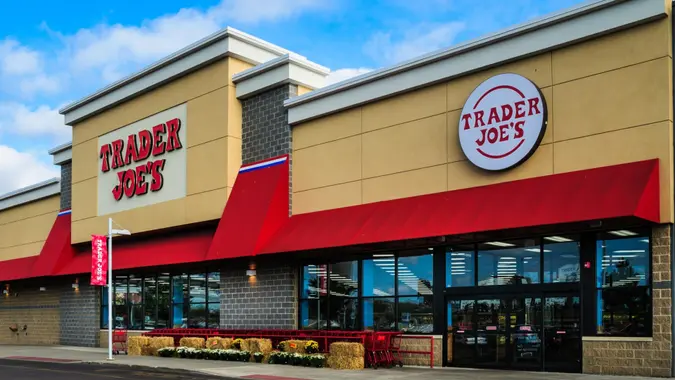Average Cost of Groceries Per Month: Are You Spending Too Much?

Commitment to Our Readers
GOBankingRates' editorial team is committed to bringing you unbiased reviews and information. We use data-driven methodologies to evaluate financial products and services - our reviews and ratings are not influenced by advertisers. You can read more about our editorial guidelines and our products and services review methodology.

20 Years
Helping You Live Richer

Reviewed
by Experts

Trusted by
Millions of Readers
Feeling the pinch at the grocery store? You’re not alone. From rising meat prices to higher delivery fees, many Americans are seeing their food bills creep up month after month.
According to the Bureau of Labor Statistics, the average household spends more than $6,000 per year on groceries — but where that money goes can vary widely. It depends on factors like what you buy, how often you shop and whether you’re paying a premium for convenience.
The Average Cost of Groceries Per Month
What does the average U.S. household spend on groceries per month? Spending averages out to about $504. But that number doesn’t tell the whole story.
For example, households that buy mostly whole ingredients may spend differently than those relying on prepared meals or snacks.
Here’s what to consider when evaluating your own grocery bill.
How Much Should You Spend on Groceries Per Month?
To determine how much you should spend on groceries each month, consider the food plans created by the U.S. Department of Agriculture. Each month, the USDA publishes food plans that estimate grocery costs at four budget levels: thrifty, low-cost, moderate-cost and liberal.
These plans can help you estimate the average cost of groceries per month based on your household size and what type of budget you’re working with.
Average Cost of Groceries for One Person
Here’s the breakdown of monthly costs for each type of food plan for one person in the 19-50 age group — and the 20-50 age group for the thrifty plan. The numbers are rounded to the nearest dollar.
| USDA Food Plan | Female | Male |
|---|---|---|
| Thrifty | $248 | $310 |
| Low-cost | $265 | $306 |
| Moderate-cost | $323 | $383 |
| Liberal | $411 | $466 |
Good To Know
The USDA food plans range from thrifty to liberal based on spending habits.
- The thrifty plan assumes cost-saving strategies like buying in bulk, shopping store brands and cooking at home.
- The liberal plan allows for more brand-name products and more convenience items.
Average Cost of Groceries for Two People
Wondering what your grocery bill should look like if you’re shopping for two? Whether you’re planning meals with a partner or cooking with a roommate, the USDA provides monthly grocery estimates you can use to budget.
Here are the estimated monthly grocery costs for a household of two adults (one male and one female).
| USDA Food Plan | Cost |
|---|---|
| Thrifty | $558 |
| Low-cost | $571 |
| Moderate-cost | $706 |
| Liberal | $877 |
Average Cost of Groceries for a Family of 4
For a family of four — two adults (one male and one female, ages 19-50 or 20-50 for the Thrifty Plan), one child aged 6-8, and one child aged 9-11 — here’s the monthly grocery cost based on each USDA food plan.
| USDA Food Plan | Cost |
|---|---|
| Thrifty | $997 |
| Low-cost | $1,078 |
| Moderate-cost | $1,327 |
| Liberal | $1,603 |
Grocery Prices by Category
Budgeting for groceries is easier if you know ahead of time how much things cost. Here’s what you can expect to pay for common grocery staples, according to the Bureau of Labor Statistics.
| Item | Measurement | Average Price |
|---|---|---|
| Ground beef | Per pound | $5.85 |
| Chicken | Per pound | $2.06 |
| Eggs | Per dozen | $6.23 |
| Milk | Per gallon | $4.05 |
| Bananas | Per pound | $0.63 |
| Oranges | Per pound | $1.48 |
| Tomatoes | Per pound | $1.82 |
| Bread (pre-made) | Per pound | $1.88 |
How Income Affects Grocery Spending and Food Access
How much you make will also determine how much you spend each month on groceries.
Higher-income households:
- Can pay more for organic produce, prepared foods and gourmet items.
- Tend to shop online more often and have better access to high-quality grocery stores.
Lower-income households:
- Must stretch every dollar, which can limit food choices.
- May not afford bulk items, which often offer better value.
According to the USDA:
- Over 13% of U.S. households experience food insecurity.
- Over 5% experience very low food security, meaning disrupted food eating patterns or reduced food intake.
Budgeting for Groceries: How To Use the 50/30/20 Rule
Without a clear budget, it’s easy to overspend on groceries — especially with fluctuating prices and impulse purchases.
The 50/30/20 rule is a simple and widely used budgeting method that helps you allocate your income into three clear categories. This rule is often recommended because it’s easy to follow and flexible enough to apply to different income levels.
Here’s how it works.
- 50% needs: This includes your grocery budget and other necessities like mortgage or rent, insurance and car payments.
- 30% wants: Things you want but aren’t necessary, such as movie tickets, concerts, travel and dining out.
- 20% savings: The remainder of your budget goes to savings and debt payments.
Pro Tip
To create a budget for your groceries, start by allocating 50% of your net income to essential needs.
Subtract non-grocery essentials (like rent or utilities) from that amount to see what’s left for food. If it’s not enough, consider redacting spending in your wants category to make room.
How To Save Money on Groceries
Planning a careful grocery shopping strategy can save you hundreds of dollars on your annual grocery tab. Here are a couple of ideas to help you get started.
- Plan weekly menus: Meal planning apps like eMeals take the guesswork out of shopping. They provide weekly menus, complete with recipes and shopping lists, for a monthly fee of $5.
- Make shopping lists: Print off a grocery list or send the list to Walmart, Kroger or other participating stores to pick up your ingredients and avoid impulse shopping. As a free alternative, the What’s for Dinner website lets you browse recipes and create your own custom shopping list.
- Use a cash-back app: Apps like Upside can also save you money. Just shop or order from a participating merchant for cash-back rewards. As of April 2025, partners include Price Chopper, Schnucks and more. The app also awards cash back at many gas stations.
- Don’t forget coupons and loyalty programs: Digital coupons and store loyalty apps can unlock exclusive deals and savings. Stack store promotions with manufacturer coupons for even deeper discounts.
FAQ
The answers to these common questions can help you create a realistic budget for groceries. Here's what you need to know.- How much will groceries cost per month in 2025?
- You can expect to spend between $400 and $500 per month on groceries for one person in 2025. The exact number depends on your dietary preferences, location, family size and where you shop.
- How much is a loaf of bread in 2025?
- According to the most recent information from the U.S. Bureau of Labor Statistics, bread costs $1.88 per pound. But you can spend less if you make bread at home or shop sales.
- What is a realistic food budget for one person?
- According to the USDA, you can expect to spend between $260 and $450 per month on food for one person. The exact price depends on the type of food you buy and where you shop.
Daria Uhlig, Cynthia Measom and Jodi Thornton-O’Connell contributed to the reporting for this article.
Data is accurate as of May 1, 2025, and is subject to change.
This article has been updated with additional reporting since its original publication.
Our in-house research team and on-site financial experts work together to create content that’s accurate, impartial, and up to date. We fact-check every single statistic, quote and fact using trusted primary resources to make sure the information we provide is correct. You can learn more about GOBankingRates’ processes and standards in our editorial policy.
- U.S. Department of Agriculture. 2025. "Official USDA Food Plans: Cost of Food at Home at Three Levels, U.S. Average, March 2025."
- U.S. Bureau of Labor Statistics. 2024. "Consumer Expenditures--2023."
- U.S. Bureau of Labor Statistics. "Average price data (in U.S. dollars), selected items."
- Progressive Grocer. "Higher Prices and Fewer Deals: Low-Income Customers Face Post-Pandemic Disparities."
- U.S. Department of Agriculture. 2024. "Household Food Security in the United States in 2023."
 Written by
Written by  Edited by
Edited by 

























